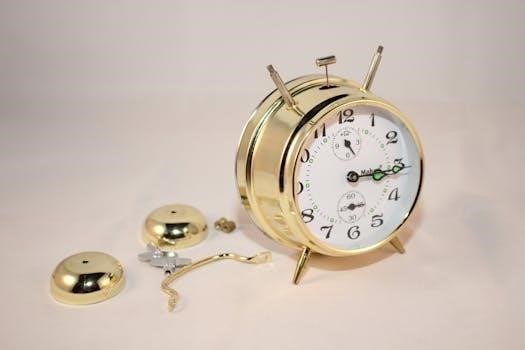arrma vorteks esc replacement instructions
Arrma Vorteks ESC Replacement⁚ A Comprehensive Guide
This guide provides instructions for replacing the Electronic Speed Controller (ESC) on an Arrma Vorteks. Whether upgrading for performance or replacing a faulty unit, this detailed walkthrough covers essential steps, from identifying the need to post-installation checks. We’ll explore various ESC options and their installation processes.
Understanding the Stock ESC
The Arrma Vorteks typically comes equipped with a stock Electronic Speed Controller (ESC) designed to handle the vehicle’s power demands in its original configuration. This ESC is usually a 3S-compatible brushless unit, often integrated with the receiver in some models, which is important to note for replacement considerations. Understanding the specifications of the stock ESC, such as its amperage rating (often around 85A or 100A) and its compatibility with the motor, is crucial before considering an upgrade or replacement. The stock ESC is built for general bashing and can handle basic speeds, but some owners may find its performance limiting, especially when pushing the vehicle to its limits or using higher-powered batteries. Many users have experienced issues with the stock ESC, including thermal shutdowns or complete failure. It’s important to know that some versions of the Vorteks may use different ESCs, which can affect the replacement procedure. The stock ESC usually has a built-in low voltage cutoff, designed to protect the battery, but this setting may be too high for some users’ preference. The ESC is designed to work with the stock motor, and it’s a key component to consider when diagnosing performance issues. The stock ESC’s wiring is also important to note when comparing it to replacement units.
Identifying the Need for Replacement
Several factors may indicate that your Arrma Vorteks ESC requires replacement. One common sign is the ESC overheating, often leading to thermal shutdowns, especially after intense use or with higher voltage batteries. Another clear indication is the complete failure of the ESC, where the vehicle doesn’t respond to throttle inputs, although the steering might still function. If you experience inconsistent power delivery, intermittent throttle, or a lack of power despite a fully charged battery, the ESC could be the culprit. Additionally, if you notice smoke or burning smells emanating from the ESC, it’s a definite sign of failure. Another reason might be the desire for a performance upgrade to handle higher voltage batteries or more powerful motors. Some users choose to replace the stock ESC due to its limitations in handling higher speeds or larger wheels. If you are seeking to improve the speed capabilities of your Vorteks, a more robust ESC is often required. Furthermore, the stock ESC’s low voltage cutoff may be set too high for some users’ preferences, which can lead to premature power cutoffs. Finally, if the ESC has sustained physical damage, such as from impacts or water exposure, replacement is necessary to ensure reliable operation.
Choosing a Replacement ESC
Selecting the right replacement ESC for your Arrma Vorteks is crucial for optimal performance and reliability. Several brands offer compatible ESCs, each with unique features. Spektrum Firma ESCs are popular choices, often bundled with compatible motors for a complete upgrade. These ESCs often incorporate smart technology and telemetry features, allowing for real-time data monitoring. Hobbywing ESCs are another common option, known for their durability and robust performance, especially in high-stress bashing scenarios. They offer a wide range of models suitable for various power requirements and budgets. Castle Creations ESCs are often favored by enthusiasts seeking top-tier performance, providing high power handling and advanced customization options. When choosing an ESC, consider the motor you plan to use. Ensure that the ESC’s amp rating is sufficient to handle the motor’s power draw. It’s wise to select an ESC with a higher rating than required, providing a safety margin and preventing overheating. Also, think about the types of batteries you intend to use; the ESC should be compatible with the voltage and cell count of your chosen battery. Other factors to consider include the ESC’s size, mounting options, and programmable features. Finally, read reviews and forums to gather user feedback on different ESC models.
Spektrum Firma ESC Installation
Installing a Spektrum Firma ESC in your Arrma Vorteks involves several key steps to ensure proper functionality. Begin by disconnecting the battery and removing the old ESC from the chassis, noting the routing of wires for reference. Mount the new Spektrum Firma ESC securely, using double-sided tape or screws if available. Connect the motor wires from the Spektrum Firma ESC to the motor, ensuring the polarity is correct to prevent damage. Next, connect the ESC’s receiver wire to the appropriate channel on the receiver; this is usually the throttle channel. The Spektrum Firma ESC often includes smart technology, so ensure that the receiver is compatible for full functionality. Secure all wires neatly to avoid contact with moving parts, using zip ties or wire clips. Ensure that the sensor wire, if present, is properly connected to the motor. Once all connections are made, double-check to make sure they are secure. Before powering on, familiarize yourself with the ESC’s instructions for calibration and programming. Improper calibration can cause issues or damage components. Check all mounting points are secure before proceeding to calibration.

Hobbywing ESC Installation
Installing a Hobbywing ESC in your Arrma Vorteks requires careful attention to detail for optimal performance. Start by disconnecting the battery and removing the stock ESC, paying close attention to wire routing. Mount the Hobbywing ESC securely using double-sided tape or screws if possible, ensuring it’s positioned away from moving parts and heat sources. Connect the three motor wires from the Hobbywing ESC to the motor, and ensure correct polarity or use a sensor cable if required. Attach the receiver wire from the Hobbywing ESC to the throttle channel on the receiver, making sure it’s secure. If the Hobbywing ESC has a sensor port, connect it to the motor sensor wire. Secure all wires neatly using zip ties or wire clips to prevent any interference. The Hobbywing ESC has various programming options, so follow the manufacturer’s instructions for proper calibration and setup, as this is critical for performance. Before powering on, double-check all connections and mounting points for security. Pay special attention to the motor wire connections to avoid shorts. Make sure the ESC is mounted in a way that allows for proper airflow, as heat can damage the unit. Be sure to check compatibility with your specific motor.
Castle Creations ESC Installation
Installing a Castle Creations ESC in your Arrma Vorteks involves a similar process to other ESC replacements but with specific considerations. Begin by disconnecting the battery and carefully removing the stock ESC from your Vorteks, noting the original wire routing. Mount the Castle Creations ESC using double-sided tape or screws, ensuring it’s placed away from moving parts and heat sources, while also allowing adequate airflow. Connect the three motor wires from the Castle Creations ESC to your motor, ensuring correct polarity or utilizing the sensor wire if the motor is sensored. Connect the receiver wire from the Castle Creations ESC to the throttle channel on the receiver. If you’re using a sensored motor, attach the sensor cable between the motor and the ESC, following the manufacturer’s instructions. Securely organize the wires with zip ties or wire clips, preventing any contact with moving parts or rubbing on the chassis. Castle Creations ESCs often come with advanced programming options, so consult the instruction manual for proper setup and calibration. Pay close attention to the ESC’s mounting to guarantee sufficient airflow, as overheating can cause damage. Double check all connections to prevent shorts. Always follow the Castle Creations guidelines for your specific ESC model to ensure optimal performance and safety. Be sure to check compatibility with your motor.

Wiring and Connections
Proper wiring and connections are crucial for a successful Arrma Vorteks ESC replacement. Begin by carefully disconnecting the battery and the original ESC. Note the original wiring configuration, specifically the connections for the motor, battery, and receiver. When connecting the new ESC, start by attaching the three motor wires. If your motor is sensorless, the order of these wires may not matter initially, but swapping two if the motor runs backward is an option for correction. For sensored motors, ensure the sensor cable is also connected correctly. The ESC’s receiver wire should be plugged into the throttle channel on your receiver; this is usually channel 2. Connect the battery wires to the ESC, ensuring the correct polarity is observed, red to red and black to black, and secure the connection. Organize all wires neatly, using zip ties or wire clips to keep them away from moving parts, sharp edges or heat sources. Avoid overly tight zip ties which may damage the wires. Double check every connection, making sure they are tight and secure. Any loose connections can cause issues such as a lack of power or poor throttle response, and shorts can damage components. Finally, make sure the wiring is out of the way of the vehicle’s wheels and other parts.

ESC Calibration
After wiring your new ESC, proper calibration is essential for optimal performance of your Arrma Vorteks. ESC calibration ensures that the controller correctly interprets the signals from your transmitter, resulting in precise throttle and braking control. The calibration procedure varies slightly depending on the ESC manufacturer, so always consult your ESC’s manual for specific instructions. However, a typical calibration process involves turning on your transmitter with the throttle at neutral. Next, connect the battery to the ESC, and then wait for a specific tone or LED indication confirming power. Move the throttle to full forward then listen for a confirming tone or LED, then move the throttle to full reverse and wait for confirmation. Finally, return the throttle to neutral. The ESC should now be calibrated. This process establishes the endpoints for neutral, full throttle, and full brake. Some ESCs may require a different sequence; always prioritize the manufacturer’s instructions. If your ESC has multiple modes like lipo protection, you may need to set this as well during the calibration process. After calibration, it’s advisable to test the throttle and brake response to ensure it’s smooth and accurate. If you experience any inconsistencies, repeat the calibration process.
Troubleshooting Common Issues

After installing a new ESC in your Arrma Vorteks, you might encounter some common issues. One frequent problem is the lack of throttle response, while the steering still works. This often indicates an issue with the ESC’s connection to the receiver or a calibration problem. Ensure the ESC’s signal wire is properly plugged into the correct channel on the receiver. If the connections are secure, re-calibrate the ESC as per the manufacturer’s instructions. Another issue is the ESC overheating. This can be caused by excessive gearing, a motor that is too powerful for the ESC, or insufficient cooling. Check your gear ratios and ensure they’re within the ESC’s recommended limits, and consider adding a fan to the ESC for better cooling. If the ESC is smoking or has a burnt smell, it may be damaged and require replacement. Also, be sure your battery is in good condition and fully charged. Also check for any loose wires and make sure the connections are secure. If you are unsure of what to do, contact the ARRMA Support Team for further assistance.
Post-Installation Checks and Testing
After installing your new ESC in the Arrma Vorteks, thorough checks and testing are crucial for optimal performance and safety. Begin by ensuring all wiring is securely connected and properly routed, avoiding any contact with moving parts. Double-check the ESC’s mounting to ensure it is firmly in place and cannot shift during operation. Next, perform a range test to confirm the receiver is communicating effectively with the transmitter. With the vehicle on a stand, gently apply throttle to check for smooth motor operation and responsiveness. Observe the motor for any abnormal noises or vibrations. Ensure the motor spins in the correct direction and the brakes are functioning properly. Gradually increase throttle input, checking for any signs of overheating in the ESC or motor. During testing, monitor the temperature of the ESC. If it becomes excessively hot, stop immediately and allow it to cool. Finally, perform a test run in a controlled environment to confirm the vehicle handles as expected. If any issues arise, refer back to the troubleshooting section.